Saturday, March 29, 2008
The Bruce Springsteen Bosscast, April 2008; Boogie Chillun
The Bosscast has moved to the all new Boss Tracks. I'll meet all you saints and sinners there for a regular dose of the Boss!
Saturday, March 22, 2008
Let's Spend The Night Together
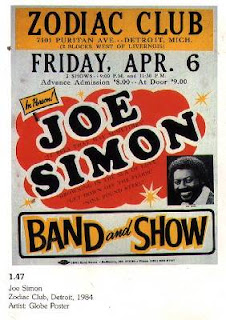 Sometimes you come across a Soul record that makes you frown. Much like R&R, Soul music often delivers best on the very edge of good taste. Some of Soul's greatest records are very dubious in that respect indeed. Are the records of Barry White still good taste, despite their candle lit pornographic aura, sure enough they are! But its a fine line. And sometimes the finest talents in Soul trip over that line. One of those rather embarrassing yet strangely entertaining examples is Joe Simon's cover of "Let's Spend The Night Together". The track is buried on Joe Simon's 1976 album "Today". The record that would definitely take Joe Simon into the Disco age. Before that Joe Simon had been one of the great Southern Soul singers. His version of "Chocking Kind" is still the definitive rendition of that song, no matter how many Joss Stones you throw at that sucker. His Gamble & Huff produced albums are bonified Soul classics out of period where Disco still meant putting a bow tie on the Funk. But shortly after those Philly productions things started to go downhill for the like of Joe Simon, maybe even Soul in general. Philly Soul evolved into Disco, a lawyer designed genre that according to George Clinton of Funkadelic fame was trying to fax it in. Countrified Soul shouters like Simon simply couldn't adapt.
Sometimes you come across a Soul record that makes you frown. Much like R&R, Soul music often delivers best on the very edge of good taste. Some of Soul's greatest records are very dubious in that respect indeed. Are the records of Barry White still good taste, despite their candle lit pornographic aura, sure enough they are! But its a fine line. And sometimes the finest talents in Soul trip over that line. One of those rather embarrassing yet strangely entertaining examples is Joe Simon's cover of "Let's Spend The Night Together". The track is buried on Joe Simon's 1976 album "Today". The record that would definitely take Joe Simon into the Disco age. Before that Joe Simon had been one of the great Southern Soul singers. His version of "Chocking Kind" is still the definitive rendition of that song, no matter how many Joss Stones you throw at that sucker. His Gamble & Huff produced albums are bonified Soul classics out of period where Disco still meant putting a bow tie on the Funk. But shortly after those Philly productions things started to go downhill for the like of Joe Simon, maybe even Soul in general. Philly Soul evolved into Disco, a lawyer designed genre that according to George Clinton of Funkadelic fame was trying to fax it in. Countrified Soul shouters like Simon simply couldn't adapt.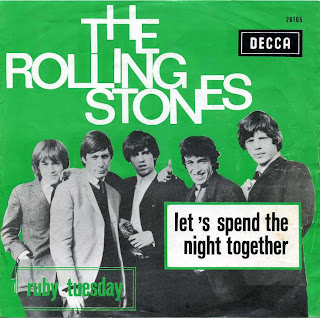 Popular myth has it that Punk destroyed Rock. I think that premises is false. Punk revived some of R&R's core values. If there's anything that "destroyed" Rock, as far as it was ever really tore down, it was Disco, F.M. Radio and mega multi million sales. F.M. Radio, which was at first a vessel for R&R, soon became predictable and overly formatted. As multi million dollar enterprises they seem to have one objective, not to offend and push as much meaningless drivel as they could. Disco suited the job just perfectly. It had none of the grits and gravy either R&R or Southern Soul had. Hell even Motown would soon prove to be too raw for the new radio formats. For the longest while F.M. wouldn't get more risky than the Eagles or Bony M. Acts like the Stones and Joe Simon suffered. But where the Stones cleverly adapted with discofied Rock as "Miss You", Simon was left stumbling through the studio with Bob Clearmountain at the production wheel. Though Clearmountain has a good reputation for producing and mixing good and solid R&R albums in a period when they were a dying breed, even he couldn't help a Soul shouter like Simon find his groove. "Today" is marred by the same problems may of the Soul albums seem to have in that era, a sense of detachment. Not quite Soul, not quite Disco and not quite the Quiet Storm that would soon come yet. On "Stay" we hear an artists clinging on to Country Soul while trying to make Disco, trying to remain true to himself while trying to blend into a crowd where he suddenly looks like the ugly duckling.
Popular myth has it that Punk destroyed Rock. I think that premises is false. Punk revived some of R&R's core values. If there's anything that "destroyed" Rock, as far as it was ever really tore down, it was Disco, F.M. Radio and mega multi million sales. F.M. Radio, which was at first a vessel for R&R, soon became predictable and overly formatted. As multi million dollar enterprises they seem to have one objective, not to offend and push as much meaningless drivel as they could. Disco suited the job just perfectly. It had none of the grits and gravy either R&R or Southern Soul had. Hell even Motown would soon prove to be too raw for the new radio formats. For the longest while F.M. wouldn't get more risky than the Eagles or Bony M. Acts like the Stones and Joe Simon suffered. But where the Stones cleverly adapted with discofied Rock as "Miss You", Simon was left stumbling through the studio with Bob Clearmountain at the production wheel. Though Clearmountain has a good reputation for producing and mixing good and solid R&R albums in a period when they were a dying breed, even he couldn't help a Soul shouter like Simon find his groove. "Today" is marred by the same problems may of the Soul albums seem to have in that era, a sense of detachment. Not quite Soul, not quite Disco and not quite the Quiet Storm that would soon come yet. On "Stay" we hear an artists clinging on to Country Soul while trying to make Disco, trying to remain true to himself while trying to blend into a crowd where he suddenly looks like the ugly duckling.The result of that strain is unfortunately an uncomfortable piece of cheese. Maybe if F.M. radio and the record business would have had the guts to invest in tail end sales as well artists like Joe Simon would have survived into the next decade. The backlash at Disco might not have been so great and might not have taken down Soul in its demise. Maybe it would have given Joe Simon enough breathing space to produce truly great records. In theory his version of "Let's Spend The Night Together" should have kicked David Bowie's ass. Unfortunately the practice of the second half of the seventies was different. Over the course of just a few years the music industry, Soul and R&R turned into an embarrassing mess. Sometimes it seems Soul never truly recovered.
"Let's Spend The Night Together" - Joe Simon
Sunday, March 9, 2008
Platter's That Matter; WAR!
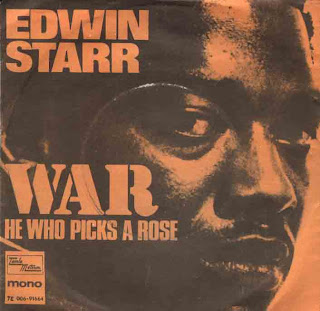 Producer Norman Whitfield is of such notoriety that one could argue that he is an artist in his own right. Although his songs were sung by others, although Gladys Knight, the Temptations and Edwin Starr scored his hits for him, his sound was so recognizable, so distinct, that you're able to pick a Whitfield production out of the thousands. The Edwin Starr single "WAR" might be his biggest triumph. Recorded and released in 1970 it is still the biggest selling protest song of all time, one of the few to hit that much coveted #1 spot on the Billboard charts. Though not the first song to deal with the war in Vietnam, few songs dealt with it so poignantly and blunt as "WAR". It is one of the few occasions where a song spawned a popular phrase; "War, what is it good for" is engraved in our collective conscious and lives a life of its own outside of the smash 45.
Producer Norman Whitfield is of such notoriety that one could argue that he is an artist in his own right. Although his songs were sung by others, although Gladys Knight, the Temptations and Edwin Starr scored his hits for him, his sound was so recognizable, so distinct, that you're able to pick a Whitfield production out of the thousands. The Edwin Starr single "WAR" might be his biggest triumph. Recorded and released in 1970 it is still the biggest selling protest song of all time, one of the few to hit that much coveted #1 spot on the Billboard charts. Though not the first song to deal with the war in Vietnam, few songs dealt with it so poignantly and blunt as "WAR". It is one of the few occasions where a song spawned a popular phrase; "War, what is it good for" is engraved in our collective conscious and lives a life of its own outside of the smash 45. Whitfield had been Motown long before the labels main money makers Holland-Dozier-Holland would leave the fold over contractual disputes. Almost single handedly Whitfield would fill the gap that the golden trio left and change the face of Motown. Although Whitfield started with material that fit the label's clean teen image like a glove he would exploit the lessened grip Berry Gordy had on Motown's musical division to the max. Together with Stevie Wonder and Marvin Gaye Norman would give Motown a decidedly more edgy image while Gordy was busy producing movies. The Temptations would be Whitfield's main showcase. As such they were the first to record the classic single that is subject of this post. The song was part of Norman's ground breaking "Psychedelic Shack" album. The title song of that album was filled with implicit references to the hippie movement and conscious expanding drugs. Yet when Norman discussed releasing War with the Temps, the explicit nature of that song proved to be a bridge to far for the group. Being too outspoken in America, with its strong patriotic (almost nationalistic) environment, could costs recording artists their career. The Temps had just broken into the exclusive club circuit and weren't about to put all that on the line. Gordy with his eyes fixed on the green might have had some to do with the Temps decision to decline as well. Next to the Supremes, the Temps were Motown's flagship. He wasn't about to compromise them.
Whitfield had been Motown long before the labels main money makers Holland-Dozier-Holland would leave the fold over contractual disputes. Almost single handedly Whitfield would fill the gap that the golden trio left and change the face of Motown. Although Whitfield started with material that fit the label's clean teen image like a glove he would exploit the lessened grip Berry Gordy had on Motown's musical division to the max. Together with Stevie Wonder and Marvin Gaye Norman would give Motown a decidedly more edgy image while Gordy was busy producing movies. The Temptations would be Whitfield's main showcase. As such they were the first to record the classic single that is subject of this post. The song was part of Norman's ground breaking "Psychedelic Shack" album. The title song of that album was filled with implicit references to the hippie movement and conscious expanding drugs. Yet when Norman discussed releasing War with the Temps, the explicit nature of that song proved to be a bridge to far for the group. Being too outspoken in America, with its strong patriotic (almost nationalistic) environment, could costs recording artists their career. The Temps had just broken into the exclusive club circuit and weren't about to put all that on the line. Gordy with his eyes fixed on the green might have had some to do with the Temps decision to decline as well. Next to the Supremes, the Temps were Motown's flagship. He wasn't about to compromise them.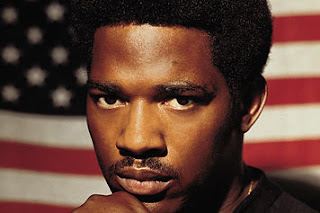 The single was then given to Edwin Starr. Although Star had scored a few hits, he wasn't quite the money machine the Temps were. Putting his career on the line wasn't as big a gamble, Starr had more to win than to loose. Starr would later recall in an interview "It was a message record, an opinion record, and stepped beyond being sheer entertainment. It could become a smash record, and that was fine, but if it went the other way, it could kill the career of whoever the artist was." The gamble paid of. With Edwin's mighty pipes and his ruff and gruff delivery "WAR" struck a very powerful chord at the time. By 1970 the Vietnam war had escalated and the draft was looming over many young men's lives. As a conflict it was unclear what America was doing there in the first place. Though the song's lyrics may seem a little hokey and to straight forward at times lines like "war, has shattered, Many a young mans dreams, Made him disabled, bitter and mean, Life is much to short and precious, To spend fighting wars these days, War can't give life, It can only take it away" hit home hard.
The single was then given to Edwin Starr. Although Star had scored a few hits, he wasn't quite the money machine the Temps were. Putting his career on the line wasn't as big a gamble, Starr had more to win than to loose. Starr would later recall in an interview "It was a message record, an opinion record, and stepped beyond being sheer entertainment. It could become a smash record, and that was fine, but if it went the other way, it could kill the career of whoever the artist was." The gamble paid of. With Edwin's mighty pipes and his ruff and gruff delivery "WAR" struck a very powerful chord at the time. By 1970 the Vietnam war had escalated and the draft was looming over many young men's lives. As a conflict it was unclear what America was doing there in the first place. Though the song's lyrics may seem a little hokey and to straight forward at times lines like "war, has shattered, Many a young mans dreams, Made him disabled, bitter and mean, Life is much to short and precious, To spend fighting wars these days, War can't give life, It can only take it away" hit home hard. "WAR" is one of those songs that stood the test of times even though its production is undeniably a product of the seventies. Norman was highly influenced by Funkadelic and Sly Stone, a product of his times. Yet when Springsteen revived the song in 2003 (Springsteen had a hit with it in the mid-eighties) after the invasion in Iraq during his Rising tour, the song sounded like it was written to comment on that colossal blunder. Still 5 years in the Iraq war has yet to find its own anthems. The war has striking parallels to the war in Vietnam. America again got itself in a senseless conflict it doesn't seem able to win. As the Dixie Chicks controversy proved protests is still a high risk to one's career. But I don't think that is why there's hardly any base for protest. The big difference between today and Vietnam is that there's no more draft. The cannon fodder of Iraq signed up voluntarily.With Vietnam because of the draft the base for protest was broader, the war harder to ignore, because it could easily come knocking on your door. Add to that an almost McCarthy like pressure to support the war, criticism seems to equal anti-Americanism these days, have silenced the popular producers. There have been a couple of high profile protesters like Eminem and Springsteen. But none of them have been as poignant as Norman Whitfield or have the reach Motown had. "WAR" is still king of all anti-war songs and I suspect it will stay that way for quite some time.
"WAR" is one of those songs that stood the test of times even though its production is undeniably a product of the seventies. Norman was highly influenced by Funkadelic and Sly Stone, a product of his times. Yet when Springsteen revived the song in 2003 (Springsteen had a hit with it in the mid-eighties) after the invasion in Iraq during his Rising tour, the song sounded like it was written to comment on that colossal blunder. Still 5 years in the Iraq war has yet to find its own anthems. The war has striking parallels to the war in Vietnam. America again got itself in a senseless conflict it doesn't seem able to win. As the Dixie Chicks controversy proved protests is still a high risk to one's career. But I don't think that is why there's hardly any base for protest. The big difference between today and Vietnam is that there's no more draft. The cannon fodder of Iraq signed up voluntarily.With Vietnam because of the draft the base for protest was broader, the war harder to ignore, because it could easily come knocking on your door. Add to that an almost McCarthy like pressure to support the war, criticism seems to equal anti-Americanism these days, have silenced the popular producers. There have been a couple of high profile protesters like Eminem and Springsteen. But none of them have been as poignant as Norman Whitfield or have the reach Motown had. "WAR" is still king of all anti-war songs and I suspect it will stay that way for quite some time."WAR" The Temptations
Saturday, March 8, 2008
Persepolis; The Real Iran.
 The biggest brow raiser to the Oscar ceremonies a few weeks back was the passing by of "Persepolis" in favor of Disney's light and breezy film "Ratatouille". It is not very often that an animated film comes a long that tackles complex issues in an accessible way. Of course the nomination alone was an enormous support to the movie. It is questionable if the film would have gotten the distribution and attention it has now if it weren't for that nomination. Even though the Oscars are hardly any indication on the merit of a film, a nomination and especially a win is still a very important promotional tool. The nomination is probably what got the movie out of the festival and art house circuit into a heavier rotation or is at the very least what got the art houses to fill up. "Persepolis" is based on the graphic novel of the same name by Marjane Satrapi. As a work of art it is most easily compared to "Maus" by Art Spiegelman. The book is highly autobiographically in nature and, like "Maus", gives us a window into the human aspect of oppression.
The biggest brow raiser to the Oscar ceremonies a few weeks back was the passing by of "Persepolis" in favor of Disney's light and breezy film "Ratatouille". It is not very often that an animated film comes a long that tackles complex issues in an accessible way. Of course the nomination alone was an enormous support to the movie. It is questionable if the film would have gotten the distribution and attention it has now if it weren't for that nomination. Even though the Oscars are hardly any indication on the merit of a film, a nomination and especially a win is still a very important promotional tool. The nomination is probably what got the movie out of the festival and art house circuit into a heavier rotation or is at the very least what got the art houses to fill up. "Persepolis" is based on the graphic novel of the same name by Marjane Satrapi. As a work of art it is most easily compared to "Maus" by Art Spiegelman. The book is highly autobiographically in nature and, like "Maus", gives us a window into the human aspect of oppression.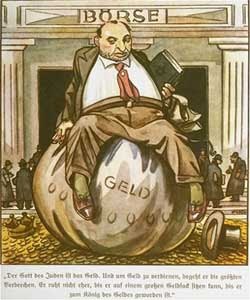 In a day and age where the debate surrounding the Arab world mainly focuses on extremism politicians and the general public risks loosing side of that aspect. President Bush's one liners on terrorism and his "axis of evil" have caused a dehumanization of the Arab world, maybe even the entire Muslim world. In the current debate there seems to be very little room for the many human differences between individual Muslims. Especially with the debate surrounding the perceived terrorist and nuclear thread of Iran we tend to loose sight of such aspects. The media focuses mainly on the insanity of the Mullahs and the president Mahmoud Ahmadinejad. In the complex dynamics surrounding the terrorist debate and the fundamentalist threat the perception of Muslims sometimes tends to take the nature of a caricature not unlike those used in Nazi Germany to portrait the Jew. Ironically it is a comic book that is now helping to give us a more realistic perspective.
In a day and age where the debate surrounding the Arab world mainly focuses on extremism politicians and the general public risks loosing side of that aspect. President Bush's one liners on terrorism and his "axis of evil" have caused a dehumanization of the Arab world, maybe even the entire Muslim world. In the current debate there seems to be very little room for the many human differences between individual Muslims. Especially with the debate surrounding the perceived terrorist and nuclear thread of Iran we tend to loose sight of such aspects. The media focuses mainly on the insanity of the Mullahs and the president Mahmoud Ahmadinejad. In the complex dynamics surrounding the terrorist debate and the fundamentalist threat the perception of Muslims sometimes tends to take the nature of a caricature not unlike those used in Nazi Germany to portrait the Jew. Ironically it is a comic book that is now helping to give us a more realistic perspective. "Persepolis" is a cultural and historical lesson, a coming of age story, a comedy and a tragedy all in one. It is against the backdrop of oppression, first by the USA supported Shah and later by the religious fanatics, that Marjane grew up. Though the film gives an insight in the terror of oppression and its mechanisms the film doesn't dwell on that. Through the terror we follow Marjane trying grow up, we get her child like perspective on Iran but we get to see a delightful charming little girl growing into a beautiful woman as well, going through most of the stages of growing up every girl goes through. As a little girl Marjane has imaginative conversations with God, who picked her to become the next profit, we see her rocking out on Iron Maiden as a teen ager, pumping herself up on "The Eye Of The Tiger" as a young adolescent. Especially funny and frightening at the same time is the scene were Marjane hits the street with her "Punk is not ded" jacket sporting a Michael Jackson button. Apparently in Iran, with its ban on music, both have an equally rebellious nature. It is that nature that get Marjane into trouble, openly opposing her religious teacher as a 13 year old, causing her parents to send her to Europe where she is faced with bigotry and the challenge of trying to fit in as a girl growing up.
"Persepolis" is a cultural and historical lesson, a coming of age story, a comedy and a tragedy all in one. It is against the backdrop of oppression, first by the USA supported Shah and later by the religious fanatics, that Marjane grew up. Though the film gives an insight in the terror of oppression and its mechanisms the film doesn't dwell on that. Through the terror we follow Marjane trying grow up, we get her child like perspective on Iran but we get to see a delightful charming little girl growing into a beautiful woman as well, going through most of the stages of growing up every girl goes through. As a little girl Marjane has imaginative conversations with God, who picked her to become the next profit, we see her rocking out on Iron Maiden as a teen ager, pumping herself up on "The Eye Of The Tiger" as a young adolescent. Especially funny and frightening at the same time is the scene were Marjane hits the street with her "Punk is not ded" jacket sporting a Michael Jackson button. Apparently in Iran, with its ban on music, both have an equally rebellious nature. It is that nature that get Marjane into trouble, openly opposing her religious teacher as a 13 year old, causing her parents to send her to Europe where she is faced with bigotry and the challenge of trying to fit in as a girl growing up.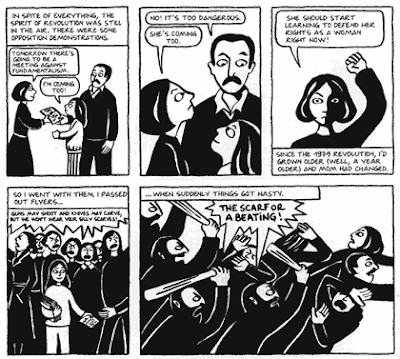
Though the film and the comic are done in black and white the way it deals with the themes is hardly that. Marjane herself has called her film a color production using gray tones. Her approach to the characters is much the same. In the book there's the Mullah who approves her application for art school despite her unorthodox view on religion, she stays with the ignorant but heartily welcoming parent of a friend in Austria, in the film she shows herself using the terror of the state to her advantage when she's in a rough spot (endangering an innocent by stander) and neighbors who are suddenly religious over night. As the characters pass through Marjane's life at the family table and the illegal parties with black market wine and lipstick the complexities of human nature comes sharply back into focus. With witty, wry irony and an almost poetic animation Marjane demonstrates how normal average people go on their way in times of dictatorship and fanaticism. She effectively shows how the terror of few can dominate the life's of many. In short, in these cynical times where one dimensional views seem to prevail, we need a one dimensional comic to gain some perspective again.
Se also this interview with Marjane for book slut and the this article from the NY Times.
The Dirty Dozen Is What's Going On!
 Take a tuba, a fat drum beat, add a scorching guitar and you've got the foundation of the Dirty Dozen Brass Band as seen in Amsterdam last Thursday. Flesh it all out with a raving horn section and you've got a combination that is guaranteed to make you sweat. The Dirty Dozen are one of those bands that is keeping the Jazz scene vibrant. Leaning heavy into the traditional music of their native city New Orleans, the Dirty Dozen keep pushing the envelope. There's a reason why they worked with everybody from Dizzy Gillespie to Elvis Costello, from the Guru to Bettye LaVette. Few other bands today are able to expand on the great Jazz traditions of New Orleans quite like them. Few bands can tackle a classic masterpiece like Marvin Gaye's "What's Going On" and get away with it. The Dirty Dozen did and pulled it off. Not just that they made an entirely original wok out of Marvin's album. So my expectations were high for the Dozen's first appearance in Amsterdam. The half filled venue made it apparent that true talent often goes unrecognized in today's music business. Unimaginative programming on the radio and MTV leave stellar bands in the realm of connoisseurs. Jazz has a high (f)art aura to it that is off putting to a lot of people. A shame, because it denies them the raving party Jazz can be.
Take a tuba, a fat drum beat, add a scorching guitar and you've got the foundation of the Dirty Dozen Brass Band as seen in Amsterdam last Thursday. Flesh it all out with a raving horn section and you've got a combination that is guaranteed to make you sweat. The Dirty Dozen are one of those bands that is keeping the Jazz scene vibrant. Leaning heavy into the traditional music of their native city New Orleans, the Dirty Dozen keep pushing the envelope. There's a reason why they worked with everybody from Dizzy Gillespie to Elvis Costello, from the Guru to Bettye LaVette. Few other bands today are able to expand on the great Jazz traditions of New Orleans quite like them. Few bands can tackle a classic masterpiece like Marvin Gaye's "What's Going On" and get away with it. The Dirty Dozen did and pulled it off. Not just that they made an entirely original wok out of Marvin's album. So my expectations were high for the Dozen's first appearance in Amsterdam. The half filled venue made it apparent that true talent often goes unrecognized in today's music business. Unimaginative programming on the radio and MTV leave stellar bands in the realm of connoisseurs. Jazz has a high (f)art aura to it that is off putting to a lot of people. A shame, because it denies them the raving party Jazz can be. If there is one thing that the Dirty Dozen seem to understand is that Jazz has a strong tradition of being party music. "It don't mean a thing if it ain't got that swing" is a lesson some Jazz combos seem to have lost sight of. While experimental forms of Jazz are not without their own merits, they are hardly ever fun and cooking quite in the original sense of the word. Most Jazz clubs or performances today attract people who quietly sit and listen, stroking their chin in contemplation while secretly fighting sleep and boredom. The Dirty Dozen may not be as subtle live as on record but they do bring the Funk. The Dozen live drop bomb after bomb. Drummer Terence Higgins has a high Hip Hop sensibility, pushing and pulling with an approach that is both sloppy, loose and incredibly tight. You can't help but throw your hands in the air, wave em like you just don't care. The horn section adds a booty shaking grease that makes it impossible to sit down. If the Dirty Dozen don't get you off your ass it is advised to check your vital signs. You might be dead.
If there is one thing that the Dirty Dozen seem to understand is that Jazz has a strong tradition of being party music. "It don't mean a thing if it ain't got that swing" is a lesson some Jazz combos seem to have lost sight of. While experimental forms of Jazz are not without their own merits, they are hardly ever fun and cooking quite in the original sense of the word. Most Jazz clubs or performances today attract people who quietly sit and listen, stroking their chin in contemplation while secretly fighting sleep and boredom. The Dirty Dozen may not be as subtle live as on record but they do bring the Funk. The Dozen live drop bomb after bomb. Drummer Terence Higgins has a high Hip Hop sensibility, pushing and pulling with an approach that is both sloppy, loose and incredibly tight. You can't help but throw your hands in the air, wave em like you just don't care. The horn section adds a booty shaking grease that makes it impossible to sit down. If the Dirty Dozen don't get you off your ass it is advised to check your vital signs. You might be dead. The material the Dozen picked to play was aimed at getting the audience into a sweaty Funk. After they were done my arm pits reminded me of the true meaning of the word. With the chops of the Dirty Dozen a classic like "When The Saint Come Marching In" sounds as fresh and funky as "Fire On The Bayou" or "Feet Can't Fail Me Now". Although the band was struggling with the acoustics of the venue some, they paid their dues and then some. The Dirty Dozen is the kind of band that doesn't play for you, they party with you. They are there for their own pleasure as well as yours. Though very accomplished musicians they never loose themselves in pointless solos for musicians sake. Still their music is adventurous and incredibly original. With the Dirty Dozen the music of New Orleans is as vital, challenging and cooking as it was a hundred years back.
The material the Dozen picked to play was aimed at getting the audience into a sweaty Funk. After they were done my arm pits reminded me of the true meaning of the word. With the chops of the Dirty Dozen a classic like "When The Saint Come Marching In" sounds as fresh and funky as "Fire On The Bayou" or "Feet Can't Fail Me Now". Although the band was struggling with the acoustics of the venue some, they paid their dues and then some. The Dirty Dozen is the kind of band that doesn't play for you, they party with you. They are there for their own pleasure as well as yours. Though very accomplished musicians they never loose themselves in pointless solos for musicians sake. Still their music is adventurous and incredibly original. With the Dirty Dozen the music of New Orleans is as vital, challenging and cooking as it was a hundred years back."What's Going On (live)"
The Dirty Dozen "Live At Paradiso" is available through the Dime.
Sunday, March 2, 2008
Take A Good Look At What You Missed All These Years
 A squealing farfisa, barely in time hand claps, raggedy harmonies, the Fleshtones are back!!!! "The who?!?" you might ask yourself. I feel for you. Asking that very question is admitting your life has been devoid of the purest brand of R&R up till now. The Fleshtones have been giving it up for years. They played CBGB's when Kurt Cobain was still crapping his pants. They blew the Ramones and Blondie off stage when the word Punk had yet to be invented. The Fleshtones were still R&R by the time the Stones traded their sex & drugs for spring water and health spas. They outlived many of Punk Rock's heroes and there seems to be no stopping them yet. Though years of scrambled together tours and albums, through years of high spirits and the lowest of lows, through thousands of sweat drenched R&R dives and dozens of guaranteed hitless albums, the Fleshtones have been the uncrowned kings of R&R. So you'd better take a good look at what you missed all those years.
A squealing farfisa, barely in time hand claps, raggedy harmonies, the Fleshtones are back!!!! "The who?!?" you might ask yourself. I feel for you. Asking that very question is admitting your life has been devoid of the purest brand of R&R up till now. The Fleshtones have been giving it up for years. They played CBGB's when Kurt Cobain was still crapping his pants. They blew the Ramones and Blondie off stage when the word Punk had yet to be invented. The Fleshtones were still R&R by the time the Stones traded their sex & drugs for spring water and health spas. They outlived many of Punk Rock's heroes and there seems to be no stopping them yet. Though years of scrambled together tours and albums, through years of high spirits and the lowest of lows, through thousands of sweat drenched R&R dives and dozens of guaranteed hitless albums, the Fleshtones have been the uncrowned kings of R&R. So you'd better take a good look at what you missed all those years.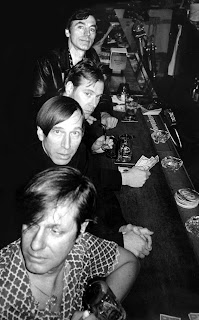 The Fleshtones have come a long way since they spawned from Brooklyn's seediest of basements. Their brand of Garage took them all over the world touring in obscurity. For some strange reason they became super stars in Paris. But then again the French are strange. But in any other country in the world they've been R&R's biggest promise for the last thirty odd years. Some bands would change their formula when confronted with the amounts of set backs the Fleshtones had to deal with. But they are not your ordinary band. They will simply keep doing what they do best, just as long as it takes for you to get it stupid! The minute the needle hits the first groove on the record, you'll know the boys haven't changed their game, though they might have perfected it a little further. Make no mistake, the raggedy mess you'll hear on "Take A Good Look" is the Fleshtones at their slickest. This album finds the band playing tighter than they ever have, finds them crashing into their songs with the greatest conviction, with a production that is on par with their finest work. In other words, they are still trying to keep up with their R&B heroes and failing gloriously. Taking you down with howling harmonica solos, blazing sax honking, rollicking piano strides, scotching guitar riffs, worn down vocals and just a little more sweat for comfort. This is what R&R is supposed to be, what it needs to be. R&R isn't pleasant, no matter what your FM radio is trying to tell you, R&R is the jumbled mess that is the Fleshtones.
The Fleshtones have come a long way since they spawned from Brooklyn's seediest of basements. Their brand of Garage took them all over the world touring in obscurity. For some strange reason they became super stars in Paris. But then again the French are strange. But in any other country in the world they've been R&R's biggest promise for the last thirty odd years. Some bands would change their formula when confronted with the amounts of set backs the Fleshtones had to deal with. But they are not your ordinary band. They will simply keep doing what they do best, just as long as it takes for you to get it stupid! The minute the needle hits the first groove on the record, you'll know the boys haven't changed their game, though they might have perfected it a little further. Make no mistake, the raggedy mess you'll hear on "Take A Good Look" is the Fleshtones at their slickest. This album finds the band playing tighter than they ever have, finds them crashing into their songs with the greatest conviction, with a production that is on par with their finest work. In other words, they are still trying to keep up with their R&B heroes and failing gloriously. Taking you down with howling harmonica solos, blazing sax honking, rollicking piano strides, scotching guitar riffs, worn down vocals and just a little more sweat for comfort. This is what R&R is supposed to be, what it needs to be. R&R isn't pleasant, no matter what your FM radio is trying to tell you, R&R is the jumbled mess that is the Fleshtones.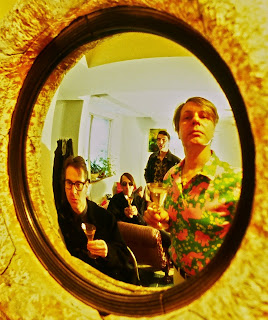 It is rare to find a band so consistent as the Fleshtones. You can pick up almost any record of theirs and get exactly what you expected. The best dose of pure R&R that will have you bopping through the room. The Watusi, the Penguin, the Funky Chicken, the Tighten Up, you'll find yourself doing all those crazy dances even if you never knew how. "Shiney Hiney" is a piece of R&R poetry that would make the Ramones proud, "Going Back To School" with its throbbing base will have the Stones hiding in shame, "New York City" is the great classic Gary 'US' Bonds never wrote, "Jet Set Fleshtones" makes the Faces look like they don't know Pub-Rock. In a better world the latter would rocket up to the top of the charts. The rudimentary farfisa licks, the vicious guitar riffing, the clunky tambourine, are catchier than they should be. Look out! They are indeed the Jet Set Fleshtones, everybody move on up and take a real good look at what you denied yourself all those years. Take a good look, because the Fleshtones are breaking through, dragging you into their world howling and screaming. Pick up the record and get cool online extras from their record company Yep Roc records, see them in a town near you, let them sink in through a blue wale haze. Don't try to fight it, the Fleshtones will make it feel good to feel!!!
It is rare to find a band so consistent as the Fleshtones. You can pick up almost any record of theirs and get exactly what you expected. The best dose of pure R&R that will have you bopping through the room. The Watusi, the Penguin, the Funky Chicken, the Tighten Up, you'll find yourself doing all those crazy dances even if you never knew how. "Shiney Hiney" is a piece of R&R poetry that would make the Ramones proud, "Going Back To School" with its throbbing base will have the Stones hiding in shame, "New York City" is the great classic Gary 'US' Bonds never wrote, "Jet Set Fleshtones" makes the Faces look like they don't know Pub-Rock. In a better world the latter would rocket up to the top of the charts. The rudimentary farfisa licks, the vicious guitar riffing, the clunky tambourine, are catchier than they should be. Look out! They are indeed the Jet Set Fleshtones, everybody move on up and take a real good look at what you denied yourself all those years. Take a good look, because the Fleshtones are breaking through, dragging you into their world howling and screaming. Pick up the record and get cool online extras from their record company Yep Roc records, see them in a town near you, let them sink in through a blue wale haze. Don't try to fight it, the Fleshtones will make it feel good to feel!!!"The Jet Set Fleshtones"
Saturday, March 1, 2008
Fela Kuti; Music As A Force
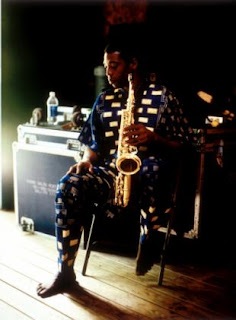 Music is often a cultural and political force as much as it is entertainment. It is a means to get views of a counter movement across to a mass audience. Music has derived that power from its Folk roots all over the world, when music was the primary a source of communication for the poor. Before there was recorded music that made musicians into stars, musicians were simply carriers of the messages, story tellers. No one knew who originally wrote the songs they were singing, in a time before publishing this was not important. When music came into the recording/publishing age this political aspect became more personalized, associated with the artist. It also started to become diluted in favor of commercial interests. Rarely there was an artist so political in the recording age as Fela Kuti. Rarely there was an artists who refused to compromise as much as this African force. Rarely there was an artist so close to the Folk roots of music while pushing the boundaries of music at the same time. Fela Kuti revolutionized in music as much as he did in thought and politics. Even though is ideas were often unrealistic and far fetched he played the confrontational game like no other. During his career he was living proof that Music can be a life changing and political force.
Music is often a cultural and political force as much as it is entertainment. It is a means to get views of a counter movement across to a mass audience. Music has derived that power from its Folk roots all over the world, when music was the primary a source of communication for the poor. Before there was recorded music that made musicians into stars, musicians were simply carriers of the messages, story tellers. No one knew who originally wrote the songs they were singing, in a time before publishing this was not important. When music came into the recording/publishing age this political aspect became more personalized, associated with the artist. It also started to become diluted in favor of commercial interests. Rarely there was an artist so political in the recording age as Fela Kuti. Rarely there was an artists who refused to compromise as much as this African force. Rarely there was an artist so close to the Folk roots of music while pushing the boundaries of music at the same time. Fela Kuti revolutionized in music as much as he did in thought and politics. Even though is ideas were often unrealistic and far fetched he played the confrontational game like no other. During his career he was living proof that Music can be a life changing and political force.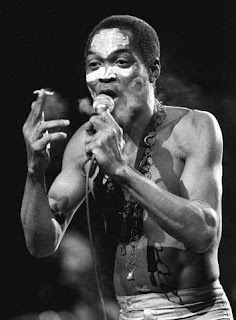 The Nigerian Kuti, produced album length singles that literally seemed to start revolutions. His Afro Beat was an explosive mix of African Rhythms and James Brown Funk, cooking and sweating in a way that might have even made the God Father jealous. Although in his biography James Brown denies being aware of African music before seeing Fela play in Nigeria, it is clear that his JB's picked up on that beat. After visiting Africa, James Brown's Funk seemed to grow more ferocious, getting into locked into the beat even tighter. Fela Kuti's Afro Beat seemed to suit the radicalizing atmosphere of Funk in the seventies like a glove. Nothing quite took the message home the way Fela's relentless and hypnotic Rhythms did. Fela's records often start with a beat, slowly building rhythm on rhythm. Punching horn lines start to spar with each other, the pulsing rhythm getting thicker and thicker. It would not be uncommon for you to be in a sweat drenched dance, minutes into the song before the vocals would even start. But when it did Fela's voice commanded immediate attention. Maybe that's why Fela was feared as much by the various regimes in Nigeria he lived through. The powers that be must have realized Fela got people to listen. Fela told the story the politicians of Nigeria refused to tell, blinded by their power. Fela tapped into the realities of the average Nigerian during shows that would stretch on for hours while explaining where their poverty came from. Although Fela aimed at the powers that be, in songs like "Colonial Mentality" he addressed the apathy of the common African as well. Kuti's music was designed to move more than your feet, he wanted elevate the political conscious of his audience as well, get them to confront their rulers.
The Nigerian Kuti, produced album length singles that literally seemed to start revolutions. His Afro Beat was an explosive mix of African Rhythms and James Brown Funk, cooking and sweating in a way that might have even made the God Father jealous. Although in his biography James Brown denies being aware of African music before seeing Fela play in Nigeria, it is clear that his JB's picked up on that beat. After visiting Africa, James Brown's Funk seemed to grow more ferocious, getting into locked into the beat even tighter. Fela Kuti's Afro Beat seemed to suit the radicalizing atmosphere of Funk in the seventies like a glove. Nothing quite took the message home the way Fela's relentless and hypnotic Rhythms did. Fela's records often start with a beat, slowly building rhythm on rhythm. Punching horn lines start to spar with each other, the pulsing rhythm getting thicker and thicker. It would not be uncommon for you to be in a sweat drenched dance, minutes into the song before the vocals would even start. But when it did Fela's voice commanded immediate attention. Maybe that's why Fela was feared as much by the various regimes in Nigeria he lived through. The powers that be must have realized Fela got people to listen. Fela told the story the politicians of Nigeria refused to tell, blinded by their power. Fela tapped into the realities of the average Nigerian during shows that would stretch on for hours while explaining where their poverty came from. Although Fela aimed at the powers that be, in songs like "Colonial Mentality" he addressed the apathy of the common African as well. Kuti's music was designed to move more than your feet, he wanted elevate the political conscious of his audience as well, get them to confront their rulers.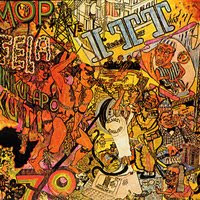 Name dropping vice president Moshood Abiola, former ITT employee (an American manufacturer with large defense contracts), in his single "International Thief Thief" got Fela arrested in the late seventies for the first time, but it wouldn't be the last. Fela's politics didn't stop there. Kuti was highly influenced by the Black Power movement and Malcolm X in his political thinking. A glance at Kuti's political career makes it apparent that Kuti took Malcolm's "By all means necessary" quite literally. Kuti claimed independence for his large estate in 1974, declaring the Kalakutu Republic, building a large fence around his estate. In '77 his "republic" was overthrown by the Nigerian government in an attack by a 1.000 soldiers. The attack left Fela's skull fractured. This however didn't stop Kuti, he formed his own political party in 1979 and tried to run as president. His campaign spearheaded one issue, he'd make every Nigerian citizen a police officer. Claiming that would stop police brutality since you cannot beat a colleague. His candidacy was denied. Fela was no doubt feared by the political establishment, his music had literally incited a riot in 1978 during the Accra show when he performed "Zombie". No telling where Fela would have ended up might he have run.
Name dropping vice president Moshood Abiola, former ITT employee (an American manufacturer with large defense contracts), in his single "International Thief Thief" got Fela arrested in the late seventies for the first time, but it wouldn't be the last. Fela's politics didn't stop there. Kuti was highly influenced by the Black Power movement and Malcolm X in his political thinking. A glance at Kuti's political career makes it apparent that Kuti took Malcolm's "By all means necessary" quite literally. Kuti claimed independence for his large estate in 1974, declaring the Kalakutu Republic, building a large fence around his estate. In '77 his "republic" was overthrown by the Nigerian government in an attack by a 1.000 soldiers. The attack left Fela's skull fractured. This however didn't stop Kuti, he formed his own political party in 1979 and tried to run as president. His campaign spearheaded one issue, he'd make every Nigerian citizen a police officer. Claiming that would stop police brutality since you cannot beat a colleague. His candidacy was denied. Fela was no doubt feared by the political establishment, his music had literally incited a riot in 1978 during the Accra show when he performed "Zombie". No telling where Fela would have ended up might he have run.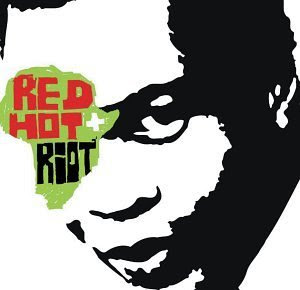 Kuti eventually died of AIDS in '97, though his supporters claim that he died because of government harassment. Fela was paid tribute on the excellent "Red, Hot and Riot" AIDS benefit lp. The guests on that LP stand as a testimony of his influence on modern music. The likes of Sade, Roy Hargrove, Common, Meshell N'Degeocello and D'Angelo all contributed to this Hip Hop infused LP that did Fela the justice he deserved. Bootsy Collins and Ginger Baker were amongst his early admirers but his legacy continues even today. A few years back Damon Albarn from from Blur fame produced an album for Kuti's drummer Tony Allen, bands like Antibalas made their careers by copying Fela's sound, while his own son Femi Kuti continues to carry the torch with his own ban the Positive Force. His legacy also means countless compilations that often need to be approach with caution. The nature of Fela's music means that his songs would often stretch over two album sides. I believe they are best enjoyed that way. But it does leave the starting listener with quite the challenge on where to begin. Wrasse records' recent release offers a good starting point. Mind you, much of Fela's most notorious work is missing from this collection, but it does give you a good sense of the force that was Fela. It comes with a DVD to boot. The two disc Universal compilation Universal released in '99 does much better on picking key tracks, and since there is hardly any overlap between that one and the Wrasse's anthology I simply recommend buying both. For those who want the complete picture try to find the LP boxed sets Barclay issued some ten years ago reproducing the original LPs. Where ever you start, you'll find that diving into Fela's music is an addictive journey leaving you wanting more, more, more.......
Kuti eventually died of AIDS in '97, though his supporters claim that he died because of government harassment. Fela was paid tribute on the excellent "Red, Hot and Riot" AIDS benefit lp. The guests on that LP stand as a testimony of his influence on modern music. The likes of Sade, Roy Hargrove, Common, Meshell N'Degeocello and D'Angelo all contributed to this Hip Hop infused LP that did Fela the justice he deserved. Bootsy Collins and Ginger Baker were amongst his early admirers but his legacy continues even today. A few years back Damon Albarn from from Blur fame produced an album for Kuti's drummer Tony Allen, bands like Antibalas made their careers by copying Fela's sound, while his own son Femi Kuti continues to carry the torch with his own ban the Positive Force. His legacy also means countless compilations that often need to be approach with caution. The nature of Fela's music means that his songs would often stretch over two album sides. I believe they are best enjoyed that way. But it does leave the starting listener with quite the challenge on where to begin. Wrasse records' recent release offers a good starting point. Mind you, much of Fela's most notorious work is missing from this collection, but it does give you a good sense of the force that was Fela. It comes with a DVD to boot. The two disc Universal compilation Universal released in '99 does much better on picking key tracks, and since there is hardly any overlap between that one and the Wrasse's anthology I simply recommend buying both. For those who want the complete picture try to find the LP boxed sets Barclay issued some ten years ago reproducing the original LPs. Where ever you start, you'll find that diving into Fela's music is an addictive journey leaving you wanting more, more, more.......See also the interview with Fela on the Shrine.
"Colonial Mentality"
Subscribe to:
Posts (Atom)
